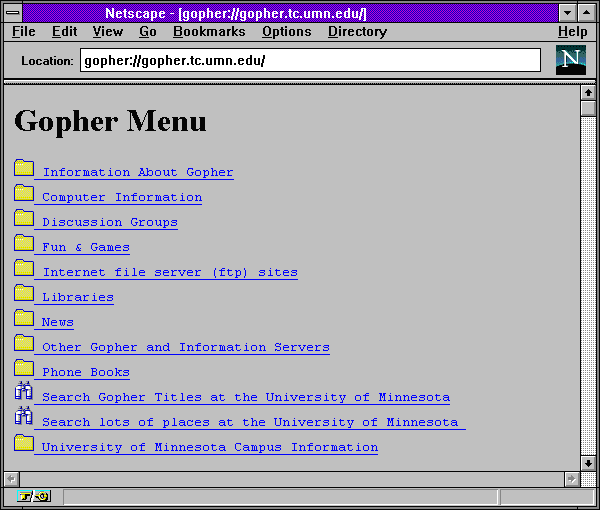The First Search Engines: Archie and Gopher
Introduction
The advent of the Internet revolutionized the world of communication and information, allowing unprecedented connectivity. Before the emergence of modern search engines such as Google, Bing, and Yahoo, there were pioneers who laid the groundwork for online navigation and search. Among these, two of the first search engines were Archie, developed in 1990, and Gopher, created in 1991. In this article, we will explore the history, features, and impact of these innovative search tools.
The Birth of Archie
Historical Context
In the late 1980s, the Internet was still in its infancy, and information was distributed across various FTP (File Transfer Protocol) servers. There was no simple way to find specific files among millions of directories. It was in this context that Peter J. Deutsch, a student at McGill University in Montreal, Canada, developed Archie in 1990.
How Archie Works
Archie, short for "Archives," was a program that allowed the indexing of contents from public FTP servers. The system worked by periodically retrieving directory listings from these servers and creating a searchable database. Users could then query this database to find files of interest.
The process was simple but revolutionary for its time:
- Crawling: Archie regularly visited FTP servers to update its directory listings.
- Indexing: The directory listings were indexed in a central database.
- Search: Users could query the Archie database via a command-line interface to find desired files.
Limitations of Archie
Despite its innovation, Archie had some limitations:
- Simple Text: Archie indexed only the names of files and directories, without internal textual content.
- User Interface: The command-line interface was not intuitive for less experienced users.
- Periodic Updates: The database was not updated in real-time, causing potential discrepancies between available and indexed files.
The Advent of Gopher
Introduction and Development
In 1991, a year after the birth of Archie, a group of developers at the University of Minnesota, led by Mark P. McCahill, introduced Gopher. This new system aimed to organize and make documents accessible in a hierarchical and intuitive structure.
Features of Gopher
Gopher was an information distribution system that organized documents in a hierarchical format similar to a file system. Its main features included:
- Menu Structure: Gopher presented information through text menus, allowing users to navigate between directories and documents intuitively.
- Accessibility: Gopher servers could host various types of documents, including texts, images, and binary files.
- User-Friendly Interface: Compared to Archie's command-line interface, Gopher offered a more user-friendly interface based on text menus.
How Gopher Works
Gopher's functionality was based on a hierarchical structure:
- Menu: Users started with a main menu listing various categories or directories.
- Navigation: By selecting a category, users could further navigate through sub-menus until finding the desired document.
- Access to Documents: Once the document was found, it could be viewed or downloaded.
The Impact of Gopher
Gopher had a significant impact on the organization and access to information on the Internet:
- Organized Structure: Gopher introduced a structured way to organize content, making it easier to find specific information.
- Rapid Spread: Within a few years, thousands of Gopher servers were operational worldwide, making a wide range of information available.
Decline of Gopher
Despite its initial success, Gopher began to decline with the advent of the World Wide Web and the HTTP protocol, which offered greater multimedia capabilities and a more advanced graphical interface.
Comparison Between Archie and Gopher
Similarities
- Pioneers of Search: Both were among the first tools developed to facilitate searching and accessing information on the Internet.
- Independence from the Web: Both Archie and Gopher were developed before the spread of the World Wide Web and used different protocols (FTP for Archie and Gopher for Gopher).
Differences
- Search Functionality: Archie focused on searching files by name, while Gopher organized documents in a more navigable hierarchical structure.
- User Interface: Archie's command-line interface was less intuitive compared to Gopher's text menus.
- Types of Content: Gopher supported a wider range of content, including text documents, images, and binary files, while Archie limited itself to indexing file names.
The Legacy of Archie and Gopher
Innovations and Influences
Archie and Gopher laid the foundation for subsequent developments in search engines and information management systems on the Internet. Their innovations can be summarized as follows:
- Content Indexing: Archie introduced the concept of indexing, which would be fundamental for future search engines.
- Organized Structure: Gopher demonstrated the importance of an organized and navigable structure for accessing information.
- Accessibility: Both contributed to making information more accessible to users, albeit in different ways.
Evolution of Search Engines
With the advent of the World Wide Web, new search engines such as WebCrawler, Lycos, and eventually Google, built on the foundations laid by Archie and Gopher. These new search engines introduced sophisticated indexing techniques, ranking algorithms, and advanced user interfaces that further revolutionized online access to information.
Archie and Gopher represent fundamental milestones in the history of the Internet and online search. Although today they are considered obsolete compared to modern search engines, their impact and innovations continue to be recognized and appreciated. Their history reminds us how quickly technology can evolve and how important continuous innovation is in the field of information and communication.

